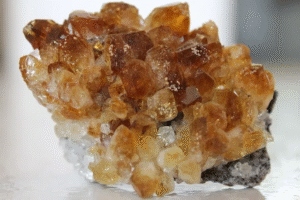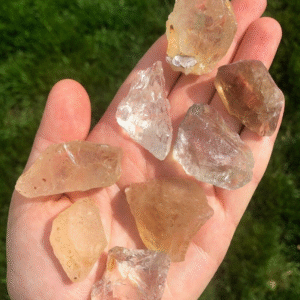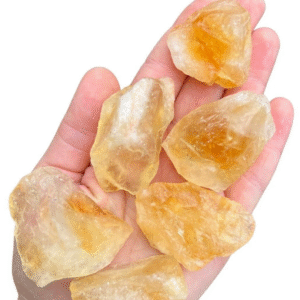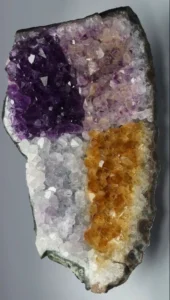
Estimated reading time :
April 17, 2025 11:13 am
Are you buying treated amethysts in the name of citrine?
Writer’s Name :
Date of Publishing :
Writer’s Name :
Arya
Estimated reading time :
What is Citrine?
Citrine is a beautiful yellow-honey-colored stone that brings light, joy, success, and positive energy into your life. Amethyst and citrine both are varieties of quartz. In fact, when amethyst and smoky quartz are exposed to high heating temperatures, they turn into this beautiful, rich, honey-yellow citrine.
Citrine is also known as the “burnt amethyst” because of its formation process. Natural citrine, smoky quartz, and amethyst are found all over the globe, but the most common place to find the heat-treated amethysts would be Brazil.
Similarities between Amethyst and Citrine
- Formation Process: The formation process of both the stones is very similar. They are formed inside geodes, and they undergo high pressure and temperature.
- Mohs Scale: On the Mohs scale, both amethyst and citrine are 7, which makes them pretty durable stones, which are perfect for various types of jewelry.
- Chemical Composition: They both are a form of quartz. As we also know that basically at one point, every citrine was an amethyst. Amethyst converted into citrine after undergoing extreme heat and pressure.
- Metaphysical Properties: Many practitioners believe that since citrine is just a type of amethyst, their metaphysical properties would also be similar. Amethyst is believed to bring calmness and clarity. Citrine is believed to be associated with energy and vitality.
How is a natural vs. treated citrine formed?
Naturally mined citrine is very rare in the market. It is formed just like amethyst deep inside the layer of earth, under intense heat and pressure. Amethyst, on the other hand, is found in more abundance than citrine.
Treated citrine is formed by heating an amethyst stone or a smoky quartz to a certain temperature of more than 500°C. The temperature has to be set very carefully and has to be monitored to give citrine the right amount of color and look. The heat to which it is exposed decides its appearance, which is the most important.
Heated citrine often appears in the shape of amethyst geodes. Its shape is famously described as “dog tooth-like.”. They might be pointed at the top and can be tapered at the bottom.
Natural citrine, on the other hand, can have 6-sided points. It might not be tapered at the bottom as well.
💡90% of the citrine that is available today in the market is just heat-treated amethyst.

Why is most citrine just treated amethyst?
Naturally occurring citrine is very rare in the market. Natural citrines also exhibit a dull pale yellow color, whereas the treated ones give an eye-catching golden-yellow color, which makes them more sellable.
Hence, to draw more buyers, treated citrine dominates the market because of the rich color it exhibits. We hope this clears out the confusion of why is heat-treated amethyst sold as citrine?
There are, however, two sides to the coin. Many people don’t believe in buying these treated varieties of citrines. However, many believe that heating them in the lab is just the same thing, as they also undergo the same process of getting heated under the earth’s layers.
How to Differentiate between a Treated or Natural Citrine?
If you have been using treated citrine, then I’m sorry to say, natural citrines might break your heart. The most basic way and the most common way to tell them apart is by their color.
| Treated Citrine | Natural Citrine |
|---|---|
| Has a milky base or is cloudy overall | Doesn’t resemble amethyst much. Looks more like clear quartz |
| Extremely brightly colored | Varies between light yellow color to apple juice color. Does not have a bright orange look. |
| Don’t cost as much | Pricier than the heated crystals |
Take a look at both the types of citrine

Natural

Treated
To give you a better idea of the formation process, let us show you an image. This image below shows the changes in amethyst when you expose it to UV light.

- • Top Left: Untreated, Natural Amethyst
- • Bottom Left: Exposed to UV light
- • Top Right: Exposed to Heat (380 degrees celsius, 8 hours)
- • Bottom Right: Exposed to Heat (450 degrees celsius, 12 hours
What to choose? Treated amethyst vs citrine?
This might be a common question that must have popped into your head after reading this. To be honest, it really depends on your preference. It is still a citrine. It really doesn’t matter if it undergoes that heat and pressure inside the layer of earth or in your lab. Eventually it will be an amethyst turned yellow-golden. It would still possess the same healing properties but just on a slightly lighter scale.
We hope this was helpful for you to know how amethyst and citrine are linked together and how you can choose the best for yourself.
You may also like


